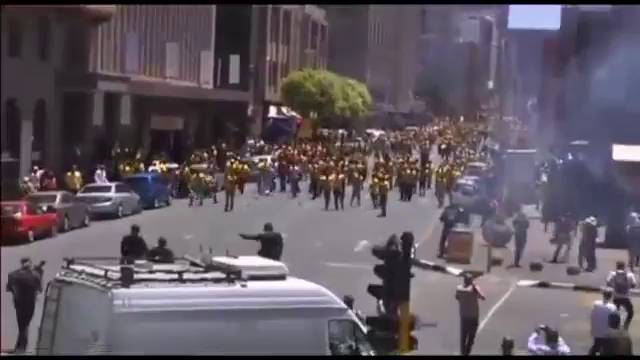Πρόκειται για μετάφραση κατευθείαν από τον google translator του ομώνυμου άρθρου της ισπανικής El Pais που μπορεί να βρεθεί, μαζί με το σχετικό βίντεο στην ηλεκτρονική διεύθυνση:
http://internacional.elpais.com/internacional/2014/02/11/actualidad/1392124633_069560.html
The South poorest protest the lack, or inadequacy of basic services such as clean water or electricity. More and more former black ghettos of theapartheid era and slums to be added to the list. Its residents take to the streets to demand a modicum of dignity after 20 years of democracy.The civil unrest is felt from one end of the country and even in Cape Town residents of the villages were organized in a march to the center to demand improvements.
Three months before the general election, scheduled for May 7, “South Africa burns” recently illustrated the popular Star newspaper with a huge photo of a burning barricade in one of the affected villages.
Protests barricades, roadblocks and attacks on public schools begin to be our daily bread in this country with the greatest social inequality in the world, an unofficial unemployment over 40% and a monthly income of less than 200 euros.
In the last three months the police have posted over 3,000 events, ie, an average of 30 per day, of which a considerable part end with violence.Only in January eight protesters were shot dead by officers, a figure to which we must add two other deaths so far this February.
Neighborhoods whose residents are protesting are full of substandard housing. Lack of pipes that carry the water to the houses, electricity and other services as a public transport. Neighbors say they are “tired of broken promises” by the government, which claims to have lost more than one million homes to the most disadvantaged in the past two decades.
This lack of services and resources forced the neighbors to be heated in winter by burning coal, which a few months ago caused fires in the barracks, thus increasing the personal dramas of those who lose their already meager belongings. A few kilometers from Pretoria , South Africa’s administrative capital, people have to do hours of queuing in a village for drinking water to cook with.
The protesters claim that although they have tried to discuss their problems with municipal services, have not received any reply and thus have decided to take to the streets. A recent study by the University of Zululand warns that “the frustration” provides that, especially among the young, may abound more and more “violent behavior”.
In fact, in recent days the protests have ended with the fire and the attack on a police station, a clinic, a library and a municipal office in different locations.
From the police, Lesetja Mothiba, head of the province of Gauteng (Johannesburg and Pretoria), just go to these protests gestures “pure criminality in the form of vandalism.” Daily agents involved in these demonstrations with live ammunition, causing injuries and even deaths.
In this sense, Riah Phiyega, the national police chief, admits that the body must change the means to disperse crowds. The slaughter of Marikana, in August 2012 that left 34 miners dead, is still very present and the police are in the thick of allegations of excesses and corruption.
The African National Congress (ANC) , the ruling party since 1994, accuses the opposition to organize and promote protests to win the political battle on the street and not in the polls.
